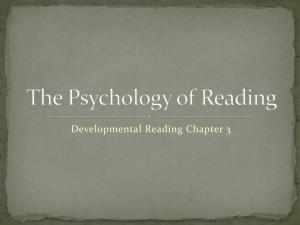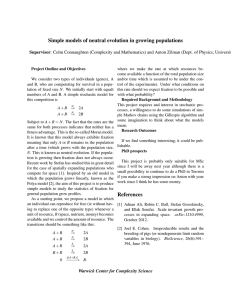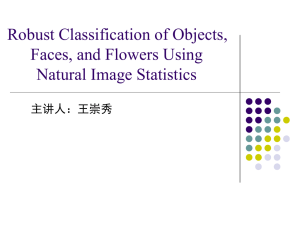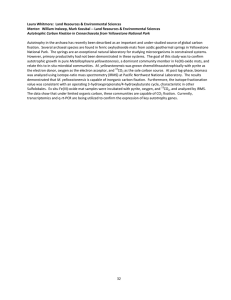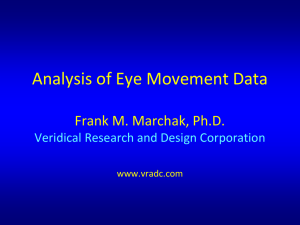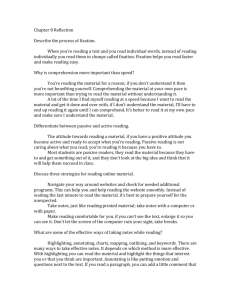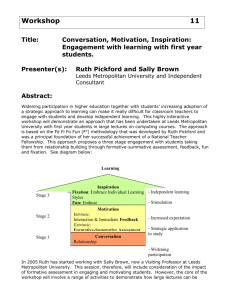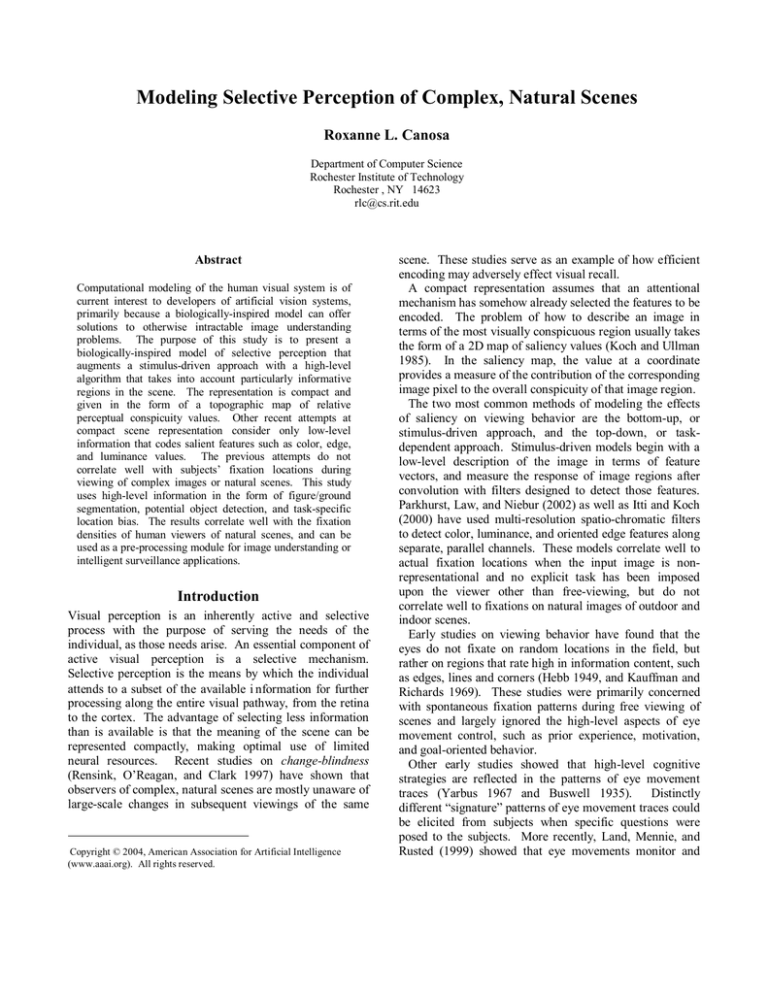
Modeling Selective Perception of Complex, Natural Scenes
Roxanne L. Canosa
Department of Computer Science
Rochester Institute of Technology
Rochester , NY 14623
rlc@cs.rit.edu
Abstract
Computational modeling of the human visual system is of
current interest to developers of artificial vision systems,
primarily because a biologically-inspired model can offer
solutions to otherwise intractable image understanding
problems. The purpose of this study is to present a
biologically-inspired model of selective perception that
augments a stimulus-driven approach with a high-level
algorithm that takes into account particularly informative
regions in the scene. The representation is compact and
given in the form of a topographic map of relative
perceptual conspicuity values. Other recent attempts at
compact scene representation consider only low-level
information that codes salient features such as color, edge,
and luminance values. The previous attempts do not
correlate well with subjects’ fixation locations during
viewing of complex images or natural scenes. This study
uses high-level information in the form of figure/ground
segmentation, potential object detection, and task-specific
location bias. The results correlate well with the fixation
densities of human viewers of natural scenes, and can be
used as a pre-processing module for image understanding or
intelligent surveillance applications.
Introduction
Visual perception is an inherently active and selective
process with the purpose of serving the needs of the
individual, as those needs arise. An essential component of
active visual perception is a selective mechanism.
Selective perception is the means by which the individual
attends to a subset of the available i nformation for further
processing along the entire visual pathway, from the retina
to the cortex. The advantage of selecting less information
than is available is that the meaning of the scene can be
represented compactly, making optimal use of limited
neural resources. Recent studies on change-blindness
(Rensink, O’Reagan, and Clark 1997) have shown that
observers of complex, natural scenes are mostly unaware of
large-scale changes in subsequent viewings of the same
Copyright © 2004, American Association for Artificial Intelligence
(www.aaai.org). All rights reserved.
scene. These studies serve as an example of how efficient
encoding may adversely effect visual recall.
A compact representation assumes that an attentional
mechanism has somehow already selected the features to be
encoded. The problem of how to describe an image in
terms of the most visually conspicuous region usually takes
the form of a 2D map of saliency values (Koch and Ullman
1985). In the saliency map, the value at a coordinate
provides a measure of the contribution of the corresponding
image pixel to the overall conspicuity of that image region.
The two most common methods of modeling the effects
of saliency on viewing behavior are the bottom-up, or
stimulus-driven approach, and the top-down, or taskdependent approach. Stimulus-driven models begin with a
low-level description of the image in terms of feature
vectors, and measure the response of image regions after
convolution with filters designed to detect those features.
Parkhurst, Law, and Niebur (2002) as well as Itti and Koch
(2000) have used multi-resolution spatio-chromatic filters
to detect color, luminance, and oriented edge features along
separate, parallel channels. These models correlate well to
actual fixation locations when the input image is nonrepresentational and no explicit task has been imposed
upon the viewer other than free-viewing, but do not
correlate well to fixations on natural images of outdoor and
indoor scenes.
Early studies on viewing behavior have found that the
eyes do not fixate on random locations in the field, but
rather on regions that rate high in information content, such
as edges, lines and corners (Hebb 1949, and Kauffman and
Richards 1969). These studies were primarily concerned
with spontaneous fixation patterns during free viewing of
scenes and largely ignored the high-level aspects of eye
movement control, such as prior experience, motivation,
and goal-oriented behavior.
Other early studies showed that high-level cognitive
strategies are reflected in the patterns of eye movement
traces (Yarbus 1967 and Buswell 1935).
Distinctly
different “signature” patterns of eye movement traces could
be elicited from subjects when specific questions were
posed to the subjects. More recently, Land, Mennie, and
Rusted (1999) showed that eye movements monitor and
guide virtually every action that is necessary to complete an
over-learned task such as making tea. Turano, Geruschat,
and Baker (2003) compared a bottom-up salience model
with a top-down guided-search model in terms of the
model’s ability to predict the oculomotor strategies of
subjects engaged in an active, natural task. The visual
salience model was found to perform no better than a
model based on random scanning of the scene. The topdown model, which incorporated geographic information in
the form of expected location criteria performed better than
the salience model. A model that used both salience
information and geography performed best of all. Feature
saliency may be a reliable indicator for determining which
regions are fixated for free-viewing simple images, but not
for oculomotor behavior that requires forming a plan of
action (Pelz and Canosa 2001).
The purpose of the present study is to propose a
biologically plausible model of selective visual attention
that incorporates low-level feature information from the
scene with high-level constructs and top-down, taskoriented constraints. The model takes the form of a
topographic map of perceptual conspicuity values, and is
called a conspicuity map. The value at a coordinate in the
map is a measure of how conspicuous that coordinate is in
terms of perception. The resulting model is shown to
correlate well with the fixation densities of subjects who
viewed natural scenes.
Model Description
This section describes in detail the steps that were taken to
construct the conspicuity map. The conspicuity map
consists of three essential modules – the pre-processing
module that produces a color map and an intensity map, an
edge module that produces an orientated edge map, and an
object module that produces a proto-object map. The maps
are merged together, and an object mask is applied to the
result to inhibit areas that do not correspond to potential
objects and enhance areas that do. Figure 1 shows a
schematic of the processing modules and the resulting
importance map.
The next step is to perform a linear transform of the
tristimulus values into rod and cone responses, using the
transformation matrices given in Pattanaik, et al., (1998), as
shown in Equations 1 and 2.
L
M =
S
0.3897
- 0.2298
0
0.6890
1.1834
0
-0.0787
0.0464
1
X
Y
Z
(1)
R = -0.702X + 1.039Y + 0.433Z
(2)
The rod signal was derived from the tristimulus values as
an approximation using a linear regression of the color
matching functions and the CIE scotopic luminous
efficiency function, V’(λ), as given in Wyszecki (1982).
The cone responses are from the Hunt-Pointer-Estevez
responsivities as given in Fairchild (1998). The final preprocessing step is to compute the two opponent color
channels and the achromatic channel from the normalized
rod and cone response signals. The opponent color
channels detect chromaticity differences in the input image,
and simulate the subjective experience of color resulting
from the four chromatic primaries arranged in polar pairs –
red/green and blue/yellow.
The achromatic channel
simulates the subjective experience of luminance along the
black/white achromatic dimension.
The transformation from rod and cone responses into
opponent signals, as shown in Equation 3, uses the matrices
given in Pattanaik, et al., (1998), which follow those of
Hunt (1995), and are also used in the CIE color appearance
model of CIECAM97 (Fairchild, 1998). In Equation 3, A
refers to the achromatic channel, C1 refers to the R/G
opponent channel, and C2 refers to the B/Y opponent
channel. After the calculation of rod and cone signals, the
low-level feature maps are computed.
A
C1 =
C2
2.0
1.0
0.11
Input Image
(RGB)
1.0
-1.09
0.11
0.05
0.09
-0.22
L
M
S
Color Map
Preprocessing
Module
Intensity Map
Input Image Pre-processing
Before the low-level features of the conspicuity map can be
computed, the input image must be pre-processed to
represent the image in terms of the human early
physiological response to stimuli. The pre-processing stage
takes as input the original RGB formatted image and
performs a non-linear transform of that image from the
RGB color space to the CIE tristimulus values, X, Y, and
Z. The tristimulus values take into account the spectral
power properties of the display device (described in the
next section) and the color-matching functions of the CIE
Standard Colorimetric Observer.
Oriented
Edge
Module
Object
Module
Orientation
Map
Conspicuity
Map
Figure 1.
Protoobject
Map
Apply mask
Construction of the conspicuity map.
(3)
The Low-level Saliency Map
The saliency map consists of three low-level feature maps –
a color map, an intensity map, and an oriented edge map.
Using these three maps to represent the low-level features
of the saliency map follows Parkhurst, Law, and Niebur
(2002), and Itti and Koch (2000), however the
computational steps that derive the maps differ
significantly from the earlier approaches. The color
computation takes as input the two chromatic signals, C1
and C2. The resulting “colorfulness” of each pixel from
the input image is expressed in color-opponent space as
given in Equation 4. This value is calculated for every
pixel, resulting in the color map.
colorfulness = √ (C12 + C22)
(4)
Combining the output from the rod signal with the output
from the achromatic color-opponent channel creates the
intensity map. Thus, the total achromatic signal, AT,
consists of information originating from the cone signals as
well as from the rod signal. The rod signal is assumed to
consist of only achromatic information. Pattanaik, et al.
(1998) determined the differential weightings of the rod
and cone signals that will result in an achromatic output
which is monotonic with luminance, as given in Equation
5.
(5)
AT = A + rod / 7
The oriented edge map also takes as input the intensity
signal. To create the oriented edge map, the first stage of
processing is the computation of a multi-resolution
Gaussian pyramid (Burt and Adelson, 1983) from the
intensity signal. To create the Gaussian pyramid, the
intensity signal is sampled at seven spatial scales (1:1, 1:2,
1:4, 1:8, 1:16, 1:32, and 1:64) relative to the size of the
original input image, 1280 x 768 pixels. Each level is upscaled to the highest resolution level using bicubic
interpolation.
The second stage of processing simulates the centersurround organization and lateral inhibition of simple cells
in the early stages of the primate visual system by
subtracting a lower resolution image from the next highest
resolution image in the pyramid, and taking the absolute
value of the result. The resulting six levels of difference
images form a Laplacian cube.
Each level of the
Laplacian cube is a representation of the edge information
from the original input image at a specific scale.
Since the human visual system has non-uniform
sensitivity to spatial frequencies in an image, the levels of
the Laplacian cube must be weighted by the contrast
sensitivity function. Contrast sensitivity is modeled by
finding the frequency response of a set of difference-of
Gaussian convolution filters, and weighting each edge
image of the Laplacian cube by the response. The filters
alter the weight of each edge according to how sensitive the
human visual system is to the frequency response of that
particular edge.
The CSF weighting function begins by defining a
Gaussian convolution kernel that is the same size as the
kernel used for the bicubic interpolation described earlier,
5x5 pixels. Multiple kernels are derived from the original
kernel by successively doubling the area. This simulates
the effect of convolving a fixed size kernel with each level
of the Gaussian pyramid. After all of the kernels have been
normalized to 1, each kernel is transformed into the
frequency domain using the Fast Fourier Transform
algorithm.
Once the convolution kernels have been transformed into
the frequency domain, they can be used to create bandpass
filters that detect a specific range of frequencies in the input
image. Subtracting one frequency domain kernel from
another frequency domain kernel creates the bandpass
filters. The range of frequencies that will be detected is
determined by the frequency response of the filters.
After calibrating the frequency responses of the bandpass
filters to correspond to degrees of visual angle, the contrast
sensitivity function can be used to determine the visual
response to a particular frequency in the Laplacian edge
images. The visual responses are used as weights to be
applied to the edge images, either enhancing the edge if the
human visual system is particularly sensitive to that
frequency, or inhibiting that edge if it is not. Equation 6
gives the contrast sensitivity function used to find the
weights (from Manno and Sakrison 1974).
CSF = 2.6 * (0.0192 + 0.114 f ) ℮ -(0.114 f) ^ 1.1 (6)
The final step in the creation of the oriented edge map is
to represent the amount of edge information in the image at
varying spatial orientations. This is done by convolving the
edge image with Gabor filters at four orientations - 0°, 45°,
90°, and 135°. This simulates the structure of receptive
fields in area V1 neurons that are tuned to particular
orientations, as well as to specific spatial frequencies
(Hubel and Wiesel 1968). Figure 2 is a graphical depiction
of the basis functions used to model the receptive fields of
these neurons.
Figure 2. Basis functions of the Gabor filters used to model the
tuning of receptive fields in area V1 of striate cortex. From left,
0°, 45°, 90°, and 135°.
Once the color map, intensity map, and the oriented edge
map have been generated, they are linearly scaled from 0 to
1 and merged together to create a single low-level saliency
map by adding the values from each map together on a
pixel-by-pixel basis.
example images. These areas are where the model predicts
the viewer’s visual attention is likely to be captured.
The High-level Proto-object Map
The proto-object map is constructed in parallel with the
saliency map, and is used to identify potential objects in the
image. The algorithm is based upon detecting texture from
edge densities. The first stage involves segmenting an
estimation of the background from the foreground of the
image, using the intensity map of the image as input. The
effect of this step is that regions of relatively uniform
intensity in the image are localized, simulating the effect of
figure/ground segmentation of perceptual organization
(Rubin 1921).
For the next stage, a threshold is applied to create a
binary representation of the foreground, which is
subsequently used for edge detection. From the edge
image, regions corresponding to potential objects in the
image are grown using morphological operations. The
result is called the proto-object map and represents the
location of potential objects in the image. The proto-object
map is used along with the color map, intensity map, and
oriented edge map as an additional channel for the
calculation of conspicuity. Once the four channels have
been merged into a single map, the proto-object map is
used once again as a mask to further inhibit regions in the
image that are not likely to correspond to object locations,
and enhance those regions that are. Figure 3 shows four
example input images and the corresponding low-level and
high-level maps for each image. The bright areas in the
maps correspond to highly conspicuous regions in the
Verification of Model
In order to determine the correlation between the model
and the fixation patterns of people viewing natural scenes,
eye-tracking data was collected and analyzed.
An ASL
model 501 head-mounted eye-tracker was used to record
gaze positions, which were calculated at a video field rate
of 60 Hz providing a temporal resolution of 16.7 msec. A
50 inch Pioneer plasma display with a screen size of 1280 x
768 pixels and a screen resolution of 30 pixels/inch was
used to display the images. The display area subtended a
visual field of 60° horizontally and 35° vertically at a
viewing distance of 38 inches.
At this distance,
approximately 21 pixels cover 1° of visual angle.
Data Collection
Eleven subjects participated in the eye-tracking experiment,
all with normal or corrected to normal vision. A calibration
procedure was performed for each subject prior to the
beginning of the experiment, and checked at the end of the
experiment. After offset and drift correction the average
angular deviation from the calibration points was 0.73° ±
0.06° at the start of the experiment, and 0.56° ± 0.04° at the
end of the experiment.
Each subject viewed a total of 164 color images divided
over two sets of 82 images each. The two sets were labeled
A and B, and were counter-balanced between observers.
Figure 3. Input images with overlaid fixation plots (1st row) – from left, washroom, hallway, office, and vending. Low-level maps (2nd
row), proto-object maps (3rd row), and final conspicuity maps (4th row).
The image database represented a wide variety of
natural images, including indoor and outdoor scenes,
landscapes, buildings, highways, water sports, scenes with
people, and scenes without people. The experiment
consisted of two parts – “free-view,” where the subject
was instructed to freely view each image as long as
desired, and “multi-view,” where the subject was given an
explicit instruction before viewing the image. Free-view
always preceded multi-view.
uses knowledge about fixation locations to weight the
individual features. This knowledge can be used in a
future implementation of the map generation algorithm to
classify images and assign weights based on the
classification results. Figure 4 shows a comparison of the
F/M ratios for each of the maps for the 152 images under
the free-viewing condition.
Mean F/M Ratio for 152 Im ages Freeview
A metric was developed to measure the correlation
between the density of subjects’ fixations on a particular
image and the model predictions of fixation locations.
The metric compares the conspicuity of the fixated regions
to the average conspicuity of the map, and is referred to as
the F/M ratio.
The mean conspicuity of fixations is defined as the
average conspicuity value extracted from a map at the x,ycoordinates of the fixation locations, for all fixations on a
particular image. The mean conspicuity of the map is the
average value of the map generated from the model. The
F/M ratio is the ratio between the mean conspicuity of
fixations and the mean conspicuity of the map.
The F/M ratio is used to determine how well the model
is able to predict fixation locations. If the F/M ratio is
close to one, then the map generated from the model is not
a good predictor of fixation locations, since the mean
conspicuity of a feature map is the expected value at any
random location in the map. If the F/M ratio is higher
than one, then the map is a good predictor because the
fixations tend to be on regions of the image that the model
has computed as being highly conspicuous.
To compare the predictive power of the model using
several different feature parameters, four maps were
generated for the 164 images in the image database used
for the eye-tracking experiment. The four maps generated
are given in Equations 7, 8, 9, and 10:
CIE map = (C + I + E) / 3
P map = P
CIEP map = ((C + I + E + P) / 4) · P
C_Map = (C·w1 + I·w2 + E·w3 + P·w4) · P·w5
(7)
(8)
(9)
(10)
C refers to the color feature map, I refers to the intensity
feature map, E refers to the oriented edge feature map, P
refers to the proto-object map, and C_Map refers to the
conspicuity map. In Equation 10, w1 through w5 refer to
weights applied to the features used to derive the
conspicuity map. The weights were found using a genetic
algorithm, where a near-optimal solution was found on a
per-image basis. In essence, the genetic algorithm assigns
a weight to each feature according to how well that feature
is able to predict a fixation location. Thus, the C_Map
F/M Ratio
2.50
Results
2.00
1.50
1.00
0.50
0.00
CIE map
P map
CIEP map
C- Map
Map
Figure 4. Mean F/M ratios for four maps generated from 152
images used for the eye-tracking study.
CIE is the conspicuity map consisting of only low-level
image features such as color, luminance, and oriented edge
information with equal weighting. The correlation of CIE
conspicuity values to subjects’ fixation locations is low, as
the F/M ratio is close to 1 for nearly every image. Any
random location on the map would produce nearly as high
of a conspicuity value. P is the proto-object map used
alone. This map shows a significantly higher correlation
to fixation locations than the CIE map. CIEP uses the
proto-object map as an added feature and as a binary mask
to inhibit the features in the map that do not correspond to
potential objects. The CIEP map has a higher correlation
than either the CIE map or the P map alone does. The
C_Map shows the highest correlation to subjects’ fixation
locations, which is expected because of prior knowledge.
The improvement in F/M ratio as the maps include
more information about objects and potential objects
shows that attention is more likely to be directed to objects
in a scene, rather than to highly salient, non-object
features. This is an indication that perceptual relevancy,
rather than feature salience, guides fixation patterns.
Ultimately, a map of perceptual conspicuity rather than of
feature salience is likely to be a better predictor of fixation
locations.
A positive feature of the object-oriented approach to
predicting fixation locations is that a central bias in the
image is preserved when the bias is warranted, and not
preserved when the bias is not warranted. For example, an
analysis of fixation distances from the center of each of
the four example images found that most of the fixations
were within ±10º of the center of three of the four images
(washroom, hallway, and vending) even though the central
area comprised less than 20% of the total image area. At a
distance of ±10º, 63% of washroom fixations, 66% of
hallway fixations, 44% of office fixations, and 52% of
vending fixations were found. From this data it can be
concluded that subjects preferentially fixated the center of
these images; thus the fixations cannot be considered
randomly distributed across the image space for any of the
four example images.
To test the conspicuity map for a preserved central bias,
a random fixation sequence was generated that constricted
all fixations to a 1/16 image size window (14.5º x 8.7º).
Figure 5 shows the ratios of fixation means to map means
for the constrained fixations. The F/M ratio is high for
both the proto-object and conspicuity maps when fixations
are constrained to the centers of the washroom, hallway
and vending images. This shows that the higher-level
maps that incorporate object information correctly
simulate the general tendency to look towards the center
of an image, when that tendency is warranted. Other
proposed models (Turano, Geruschat, and Baker 2003)
include an imposed, explicit bias toward the center to
improve performance, however the object-oriented model
presented here preserves the central tendency without
artificial means.
F/M Ratios for Random Fixations
Buswell, G.T. 1935. How People Look at Pictures: A Study of
the Psychology of Perception in Art, Chicago:The University of
Chicago Press.
Fairchild, M.D. 1998. Color appearance models. Reading, MA:
Addison-Wesley.
Koch, C., and Ullman, S. 1985. Shifts in selective visual
attention: Towards the underlying neural circuitry. Human
Neurobiology, 4:219-227.
Hebb, D.O. 1949. The Organization of Behavior, New York:John
Wiley & Sons.
Hubel D.H., and Wiesel, T.N. 1968. Receptive fields and
functional architecture of monkey striate cortex. Journal of
Physiology, 195:215-243.
Hunt, R.W.G. 1995. The reproduction of color.
Kingston-upon-Thames,England: Fountain Press.
5thedition.
Itti L., and Koch, C. 2000. A saliency-based search mechanism
for overt and covert shifts of visual attention. Vision Research,
40:1489-1506.
Kaufman L., and Richards, W. 1969. Spontaneous fixation
tendencies for visual forms. Perception and Psychophysics, 5(2),
:85-88.
F/M Ratio
1/16 Image Size Window at Ce nte r
4
3
2
1
0
CIE Map
C-Map
Washroom
Hallw ay
Off ice
Vending
Im age
Figure 5. F/M ratios for random fixations restricted to 1/16
image size distance from center.
Conclusion
This study showed that locating highly conspicuous
regions of an image must ultimately take into
consideration the implicit semantics of the image – that is,
the “meaningfulness” of the contents of the image for the
viewer as exemplified by objects in that image. Objects as
well as their locations in the scene play an important role
in determining meaningfulness in natural, task-oriented
scenes, especially when combined with action-implied
imperatives. The low-level, bottom-up features of an
image cannot be ignored, however, because it is those
features that capture the attentional resources in the early
stages of processing, sometimes in an involuntary way.
Successfully predicting fixation densities in images
requires computational algorithms that combine bottom-up
processing with top-down constraints in a way that is taskrelevant, goal-oriented and ultimately most meaningful for
the viewer as well as for the particular image under
consideration.
References
Burt, P. J., and Adelson, E.H. 1983. The Laplacian pyramid as a
compact image code. IEEE Transactions on Communications,
31(4):532-540.
Hebb, D.O. 1949. The Organization of Behavior, New York:John
Wiley & Sons.
Land, M.L., Mennie, N., and Rusted, J. 1999. The roles of vision
and eye movements in the control of activities of daily living.
Perception, 28:1311-1328.
Manno, J.L., and Sakrison, D.J. 1974. The effects of a visual
fidelity criterion on the encoding of images. IEEE Transactions
of Information Theory 20(4):525-535.
Parkhurst, D., Law, K., and Niebur, E. 2002. Modeling the role
of salience in the allocation of overt visual attention. Vision
Research, 42:107-123.
Pattanaik, S.N., Ferwerda, J.A., Fairchild, M.D., and Greenberg,
D.P. 1998. A multi-scale model of adaptation and spatial vision
for realistic image display. Proceedings of the SIGGRAPH
98:287-298.
Pelz, J.B. and Canosa, R. 2002. Oculomotor behavior and
perceptual strategies in complex tasks. Vision Research,
41:3587-3596.
Rensink, R.A., O’Reagan, J.K., and Clark, J.J. 1997. To see or
not to see: The need for attention to perceive changes in scenes.
Psychological Science, 8(5):368-373.
Rubin, E. 1921. Visuell Wahrgenommene Figuren, Glydenalske
boghandel, Kobenhaven.
Turano, K.A., Geruschat, D.R., and Baker, F.H. 2003.
Oculomotor strategies for the direction of gaze tested with a realworld activity. Vision Research, 43:333-346.
Wyszecki, G., and Stiles, W.S. 1982. Color Science: Concepts
and Methods, Quantitative Data and Formulae (2nd edition).
New York: Wiley.
Yarbus, A. 1967. Eye Movements and Vision, New York: Plenum
Press.

